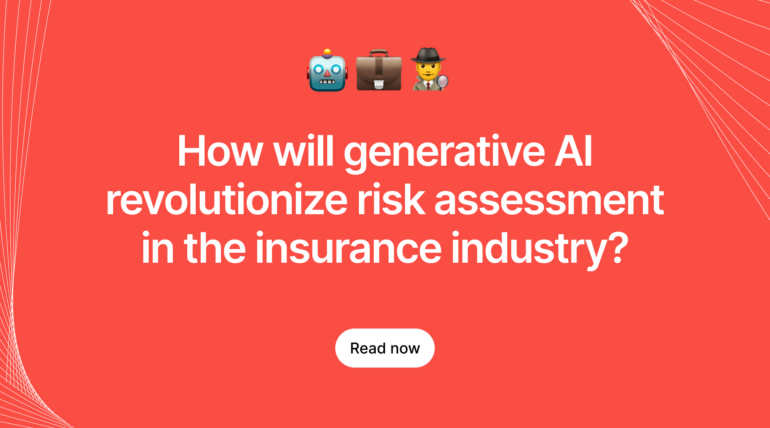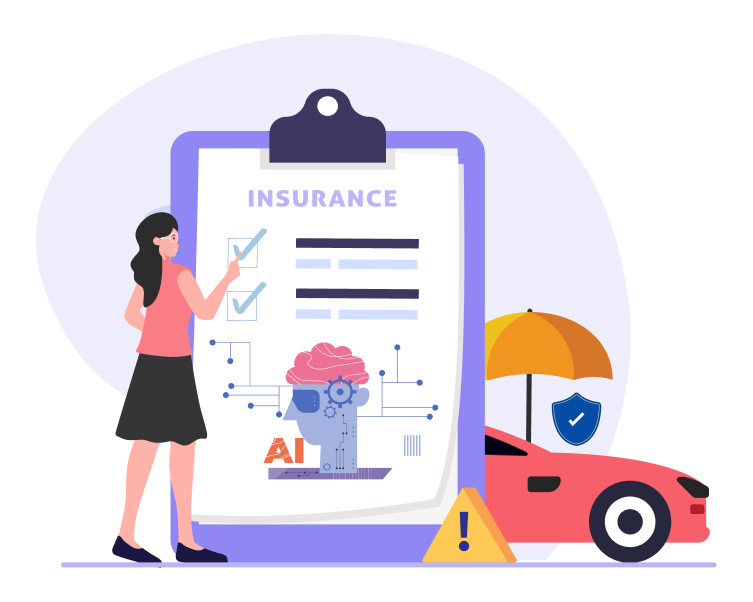
The insurance industry heavily relies on risk assessment to determine the likelihood of an event occurring and the potential financial impact it may have. Traditionally, risk assessment in insurance been carried out using manual processes and statistical models. However, generative AI can revolutionize this field and optimize risk assessment processes.
Generative AI, a subset of artificial intelligence, refers to algorithms capable of creating new and original content based on patterns and insights it learned from existing data. It has gained significant attention in recent years due to its ability to automate and enhance various processes across different industries. In the insurance industry, generative AI can transform risk assessment by improving data collection and analysis, enabling personalized risk assessment and pricing, and streamlining claims processing and fraud detection.
This article will dive into the transformative power of generative AI in risk assessment within the insurance industry. It will explore the key areas where generative AI differs from traditional risk assessment methodologies and how it can enhance data collection and analysis.
How generative AI differs from traditional risk assessment methodologies in insurance industry?
Generative AI differs from traditional risk assessment methodologies in the insurance industry in several ways. One key difference is the ability of generative AI to automate and streamline data collection processes, ensuring both accuracy and efficiency. Moreover, generative AI excels in handling unstructured data, such as customer reviews or social media data, allowing for a more comprehensive risk assessment. Additionally, generative AI enables advanced data analysis, extracting valuable insights and identifying hidden risks that may go unnoticed with traditional methodologies.

Enhancing data collection & analysis
1. Streamlining data acquisition through automation
Generative AI automates the data acquisition process, reducing the manual effort required. By utilizing web scraping techniques, generative AI can collect vast amounts of relevant data from various sources such as social media platforms, news articles, and public databases. This automation not only saves time but also ensures a more comprehensive and up-to-date data collection process.
2. Ensuring data accuracy and quality via AI algorithms
Generative AI algorithms can analyze and filter collected data to ensure its accuracy and quality. By leveraging techniques such as natural language processing and sentiment analysis, generative AI can detect potential biases or inaccuracies in the data. This enables insurance companies to make more informed risk assessments based on reliable data sources.
3. Handling unstructured data for comprehensive risk assessment
Unlike traditional risk assessment methodologies, generative AI excels in processing unstructured data. It can extract valuable information from customer reviews, social media posts, and other unstructured sources. By integrating this unstructured data into risk assessment models, insurance companies can gain a more holistic view of potential risks, enabling more accurate risk assessments.
Performing advanced data analysis with Gen AI
1. Extracting meaningful insights and patterns
Generative AI algorithms can identify meaningful patterns and insights in large datasets, which may not be apparent through manual analysis. By analyzing historical data and identifying correlations, generative AI can help insurance companies understand complex risk factors and predict future trends. This enables insurers to make data-driven decisions and mitigate potential risks more effectively.
2. Identifying hidden risks and correlations
Generative AI algorithms have the ability to identify hidden risks and correlations that may not be evident to human underwriters. By analyzing vast amounts of data and detecting patterns across different variables, generative AI can identify potential risks that were previously overlooked. This empowers insurance companies to proactively address emerging risks and adapt their risk assessment models accordingly.
3. Predictive modelling for proactive risk prevention
Generative AI can be utilized to develop predictive models that forecast potential risks and their impact on insurance portfolios. By analyzing historical data, generative AI can identify trends and predict future risks. This proactive approach allows insurance companies to develop risk prevention strategies and optimize their portfolios, ultimately reducing losses and improving profitability.
Personalized Risk Assessment and Pricing
1. Incorporating demographic and behavioral factors
Generative AI enables insurance companies to tailor risk assessment based on individual profiles. By incorporating demographic and behavioral factors, such as age, gender, occupation, and lifestyle choices, insurance companies can assess risks on a more personalized level. This personalized risk assessment helps insurers offer customized coverage and premiums that accurately reflect an individual’s risk profile.
2. Utilizing digital footprints for personalized insights
Generative AI can analyze an individual’s digital footprints, such as their online presence, social media activity, and purchasing behavior, to gain insights into their risk profile. By leveraging this data, insurance companies can better understand an individual’s lifestyle, habits, and potential risks. This allows insurers to offer personalized coverage and pricing that aligns with an individual’s specific needs and circumstances.
3. Mitigating biases through algorithmic fairness
Generative AI can help address biases that may exist in traditional risk assessment processes. By utilizing algorithmic fairness techniques, generative AI can mitigate potential biases and ensure unbiased risk assessments. This promotes fairness in insurance pricing and ensures that individuals are not unfairly penalized or excluded based on factors beyond their control.

Dynamic pricing models enabled by generative AI
1. Real-time risk evaluation for policyholders
Generative AI enables real-time risk evaluation for policyholders. By continuously collecting and analyzing data, including factors such as driving behavior, health monitoring, or home security, generative AI can provide ongoing risk assessments. This allows insurance companies to adjust premiums dynamically based on changing risk factors, providing policyholders with fair and accurate pricing.
2. Adaptive premiums based on changing risk factors
Generative AI enables insurers to offer adaptive premiums that adjust according to changing risk factors. For example, in auto insurance, generative AI can monitor driving behavior using telematics and adjust premiums accordingly. This promotes safe driving habits and incentivizes individuals to reduce risky behavior, ultimately benefiting both policyholders and insurance companies.
3. Balancing fairness and affordability in insurance pricing
Generative AI offers the potential for insurance companies to strike a balance between fairness and affordability in pricing. By incorporating personalized risk assessment and real-time evaluations, insurers can offer fair pricing while ensuring coverage remains affordable. This enables insurance companies to accurately assess risk, provide suitable coverage, and maintain profitability in a rapidly evolving industry.
Optimizing claim process automation
1. Accelerating claim validation and verification
Generative AI can automate and accelerate the claim validation and verification process. By analyzing historical claims data, generative AI can quickly assess the validity of a claim, reducing manual effort and processing time. This automation improves efficiency, allowing insurance companies to handle claims promptly and provide faster assistance to policyholders.
2. Simplifying documentation procedures
Generative AI can simplify the documentation procedures by automating the extraction of relevant information from various documents. This eliminates the need for manual data entry, reducing errors and speeding up the claims processing workflow. Insurers can leverage generative AI to extract key information from forms, medical records, and other documents, streamlining the entire claims process.
3. Reducing processing time and costs
Generative AI significantly reduces processing time and costs associated with claims handling. By automating various tasks, such as data extraction, documentation review, and fraud detection, generative AI accelerates the entire claims process. This not only improves customer satisfaction but also reduces operational costs for insurance companies, leading to overall efficiency gains.
Enhancing fraud detection with generative AI
1. Identifying suspicious patterns and anomalies
Generative AI algorithms can identify suspicious patterns and anomalies that may indicate potential fraud. By analyzing historical claims data and comparing it to current claims, generative AI can flag potential red flags for further investigation. This strengthens fraud detection capabilities and helps insurance companies identify fraudulent claims more accurately.
2. Enhancing early fraud detection algorithms
Generative AI can enhance early fraud detection algorithms by continuously learning from new data. By analyzing historical fraud patterns and incorporating new information, generative AI algorithms can evolve and adapt to new fraudulent techniques. This proactive approach not only improves fraud detection accuracy but also enables insurance companies to stay ahead of emerging fraud trends.
3. Minimizing false positives and improving accuracy
Generative AI has the potential to minimize false positives in fraud detection. By continuously learning from patterns and insights, generative AI algorithms can become more accurate in identifying genuine fraud cases. This reduces the burden on insurance companies to investigate false positives, allowing them to focus their resources on legitimate claims and improving overall fraud detection efficiency.
Summary
The implementation of generative AI in risk assessment has significant implications for the insurance industry. It enables insurers to better understand risks, offer personalized coverage and pricing, and streamline claims processing. This leads to improved customer satisfaction, reduced costs, and more efficient operations.
While generative AI holds immense potential, it also poses challenges for the insurance industry. Insurance companies need to address concerns related to data privacy, ethical use of AI, and algorithmic biases. Additionally, the integration of generative AI requires technological expertise and investment. However, with careful consideration and adoption, generative AI can reshape the future of risk assessment in the insurance industry.







